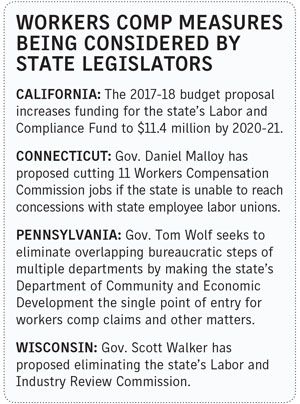Budget proposals weigh workers comp cuts
Reprints
State budget proposals that target employee safety programs and agencies, including workers compensation systems, are raising questions about the balance between federal and state oversight of workers comp and safety enforcement under the new presidential administration.
Wisconsin Gov. Scott Walker introduced Assembly Bill 64, a two-year budget bill, to the State Legislature last month with a provision that would eliminate the state’s Labor and Industry Review Commission, which reviews workers comp administrative decisions.
West Virginia Gov. Jim Justice’s budget proposal, announced last month, diverts $38 million from the $50 million designated annually to pay down unfunded comp liabilities to the state’s general fund.
The San Diego City Council’s Budget Committee voted in February to ease workers comp reserve policies to free up $25 million in the city’s budget, according to a report in the San Diego Union-Tribune.
And Pennsylvania Gov. Tom Wolf’s proposed budget, also introduced last month, includes a provision to centralize government services, including directing the state’s Department of Community and Economic Development to create a single point of entry for workers comp claims along with unemployment insurance and other services.
“We’re encouraged that the governor is considering options to improve efficiency and find cost savings as potential alternatives to tax increases to address our budget challenges,” said Alex Halper, director of government affairs for the Pennsylvania Chamber of Business and Industry in Harrisburg, Pennsylvania.
It isn’t uncommon for governors and legislators to target workers comp and labor budgets to help address a budget shortfall, observers say.
“Periodically, states have budget concerns and will look to other departments for money to help balance their budget,” said Peter Burton, senior division executive for state relations at the Boca Raton, Florida-based National Council on Compensation Insurance Inc. These budget activities don’t necessarily reflect a wider trend, he said: “It happens every two to four years.”
Mr. Burton said when states seek to make themselves more competitive, they evaluate the state’s tax structure, energy costs and other elements, including workers comp costs, that can affect how attractive a state is for businesses.
These types of budget initiatives, viewed against a backdrop of a potential shift away from federal workplace safety enforcement activities under President Donald Trump, raise questions about funding for workplace safety programs and enforcement activities.
More than 20 states have opted out of U.S. Occupational Safety and Health Administration oversight by establishing their own state OSHA agencies that are approved and partially funded by the federal agency, said Deborah Berkowitz, senior fellow with the Washington-based National Employment Law Project.
 With potential budget cuts to the federal agency on the horizon under the new administration, state enforcement budgets will also be cut, she said. Coupled with state-level legislation and budget cuts targeting workers comp, along with a trend of decreasing benefits paid to injured workers since the early 1990s, this means workers could be negatively affected, Ms. Berkowitz said.
With potential budget cuts to the federal agency on the horizon under the new administration, state enforcement budgets will also be cut, she said. Coupled with state-level legislation and budget cuts targeting workers comp, along with a trend of decreasing benefits paid to injured workers since the early 1990s, this means workers could be negatively affected, Ms. Berkowitz said.
“In the end, workers lose, and they’ll lose twice over,” Ms. Berkowitz said. “They’ll lose if they get injured, and they’ll lose because of lack of oversight of their companies.”
Nickole Winnett, an attorney at Washingtonbased law firm Jackson Lewis P.C., said state safety agencies and labor departments are often not a high priority in state budgets and do not receive all the resources they request to enforce safety and health initiatives, which results in less enforcement and compliance assistance for employers.
“A lot of states don’t have the resources or money to have a robust inspection program like the federal government does, so most states will likely maintain the level of enforcement they typically have had,” Ms. Winnett said.
Another outcome is a potential easing of tension between federal OSHA and state safety agencies, said John Martin, an attorney with Washington-based law firm Ogletree, Deakins, Nash, Smoak & Stewart P.C.
States that opt out of federal OSHA oversight are required to have a program that is considered “as effective” as the federal program, and OSHA has tended to require states to run their safety programs the same way as the federal agency, which sometimes conflicts with state laws, Mr. Martin said.
“Under the last administration, there were a lot of arguments between state and federal OSHA about what it meant to have a state plan,” Mr. Martin said. “I think we will see a little more cooperation” with the current administration.
Read Next
-
States lower costs by changing process to resolve comp disputes
While some states are looking to balance their budgets by making cuts within agencies that oversee workers compensation programs, others have taken a different direction in recent years by modifying their process for workers comp administration and adjudication.